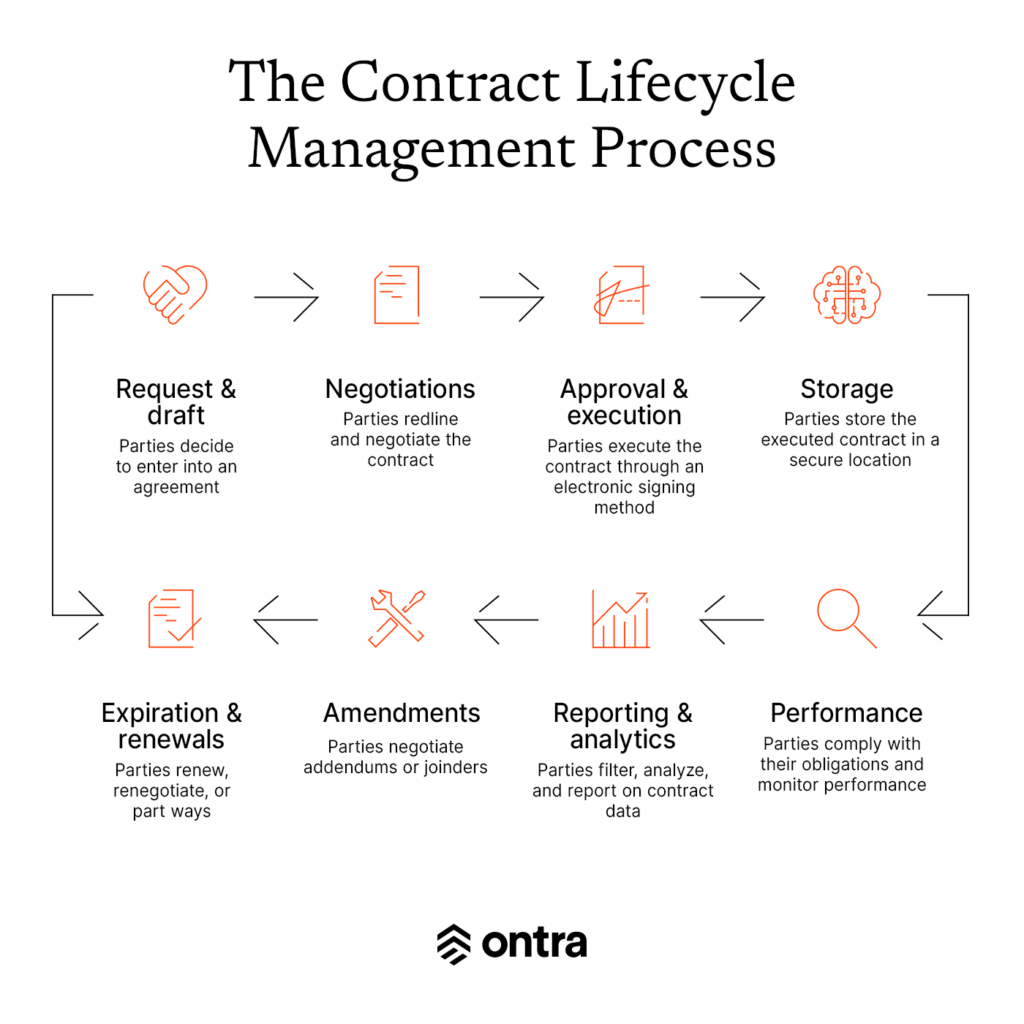Whatever the industry, businesses often handle several types of contracts on a routine basis, such as employee and independent contractor agreements, vendor contracts, and non-disclosure agreements. If they struggle to manage these contracts efficiently when they hit a high volume, it’s time for those businesses to improve their contract lifecycle management. It’s up to them, and in particular, their in-house legal departments, to take responsibility for those contracts.
Unfortunately, overseeing these agreements from beginning to end is a significant burden. In-house teams get increasingly bogged down the more routine contracts they have to handle. Lawyers end up focusing on non-core work instead of tasks that provide greater value to the company.
Businesses have to address CLM to conquer massive quantities of contracts. They can implement more efficient processes with a contract lifecycle management solution instead of relying on traditional track changes for version control and spreadsheets for organizing commitments.
What is contract lifecycle management?
Contract lifecycle management is how an organization oversees its contracts and related legal documents, from initiating a new agreement through execution, compliance, and renewal or expiration.
The term CLM implies a combination of streamlined processes and automation. It’s an advancement from the days of managing contracts through old-school spreadsheets.
What is a contract lifecycle management system?
A CLM system or contract management system is a business’s internal process and technology for executing, tracking, and enforcing contracts. It encompasses the business’s permissions, workflows, document storage, calendars and reminders, and anything else related to overseeing its agreements.
In 2023, a CLM system typically involves digital processes and solutions. But the technology businesses use varies significantly, including whether and how the solution takes advantage of artificial intelligence.
What is the difference between contract management and CLM?
How the corporate world talks about contract management and CLM has evolved. Many professionals use “contract management” to mean manual processes to handle their organizations’ contracts, such as spreadsheets, email chains, and paper files. Although, it might be more accurate to use the term “contract mismanagement.”.
CLM is a strategic approach to contracts involving some form of legal technology and more efficient workflows. However, professionals might use the terms contract management, CMS, and CLM interchangeably.
The disadvantages of manual contract management
Historically, contract management was inefficient and time-consuming — plagued with manual processes, repetitive tasks, and spreadsheets. Without consistent internal workflows and standards, businesses’ contract provisions could vary drastically, complicating their contract compliance efforts.
While spreadsheets have their time and place, they don’t help businesses effectively track contract obligations and renewals. They also lack any way to standardize provisions, extract structured data from contracts, or gain actionable insight from past agreements.
The purpose of CLM is to move businesses into a stronger position to comply with and enforce their agreements. They can get more out of their contracts with the right contract automation and management tools.
What is the contract lifecycle management process?
The CLM process includes each step of contracting, from the initial draft to renewal or expiration. Businesses must consider each stage of the contract lifecycle when transitioning from manual contract management to a more advanced CLM approach. Their in-house teams will want a smooth transition from one step to the next to speed up contract execution and mitigate the risk of noncompliance.

- Contract request and draft: The parties have decided to enter into an agreement, and one party provides the initial draft.
- Contract review and negotiations: The parties go through several stages of redlining and negotiating the contract provisions. Contract creation and review usually involve several stakeholders, though the complexity of the negotiations depends on the type of transaction and agreement. For example, routine agreements, such as NDAs, require fewer negotiations than complex transactions.
- Contract approval and execution: Once the parties agree to the contract’s wording, they will execute it through an electronic signing method.
- Contract storage: Each party must store the executed contract for their records in a secure yet accessible location.
- Contract performance and obligation management: Each party complies with its obligations and monitors the other party’s performance. This stage can last months or years and often requires the ability to quickly find, search, and review contract provisions.
- Contract reporting and analytics: Businesses benefit from being able to accumulate, filter, analyze, and report on contract data.
- Contract amendments and joinders: Sometimes, parties negotiate addendums to their contracts or use joinders to include third parties in a previously established agreement.
- Contract expiration and renewals: Eventually, the parties approach the end of the contract. They may renew their agreement, negotiate a new contract, or choose to part ways.
What is contract lifecycle management software?
Contract management lifecycle software enables parties to execute contracts faster and more efficiently by removing traditional barriers, such as emails, draft version confusion, and separate eSignature platforms. A solution geared toward contract management offers visibility into the negotiation and drafting process. As a result, there’s less confusion when the agreement evolves from one version to the next.
CLM software solutions can vary depending on the intended audience. Some offer industry-specific features, which will influence businesses in their purchasing decisions. However, all CLM solutions should have certain integral features.
Contract lifecycle management software features
- Centralized contract and legal document storage
- Machine learning and contract automation
- Automated alerts and notifications
- Reporting and analytics capabilities
- Electronic signature and other integrations
- Contract compliance features
- Access permission controls
- Managed and guided deployment
- Advanced security
Benefits of contract lifecycle management software
- Improved visibility, workflow, and collaboration
- Increased predictability and consistency
- Elimination of manual tasks
- Creation of contract templates
- Rules and permissions to enhance security
- Better redlining and version tracking
- A secure, centralized repository
- Faster execution
- Enhanced preparation for renewals
- Robust reporting capabilities
- Easy-to-track audit trails
- Lower risk of noncompliance
5 Contract lifecycle management best practices
Businesses should prioritize certain best practices when establishing a modern CLM system.
1. Create contract consistency
Above all, businesses should foster consistency within their contracts and CLM processes. For contract drafting and negotiations, this often includes standardizing provisions by contract type as much as possible through determining preferred and fallback terms. Businesses can put together contract playbooks that define their positions for routine agreements.
Employees also benefit from a standard contract process, which should define each person’s role. It should be clear who is responsible for guiding a contract through the review process, who has approval power, and who will sign the agreement on behalf of the business.
2. Expedite the contract execution process
Businesses often want to shorten the turnaround time for routine contracts, and can do so by taking advantage of legal technology, contract automation, and legal outsourcing. Businesses tackling high volumes of repetitive contracts will benefit most from automation and outsourcing, which can cut turnaround times by 50%. Those with the capacity to handle their routine agreements in-house should still leverage technology, including CLM solutions with automation features, streamlined workflows, and eSignature integrations.
3. Prioritize contract organization
A danger of traditional contract management was the lack of a central repository. Businesses often store contracts on various employees’ computers. Now, with cloud storage and contract management solutions, businesses can save digital agreements in one place.
Businesses should create file naming conventions and train their employees to name files correctly. This system distinguishes executed contracts from previous versions and makes searching for agreements easier and faster.
4. Maintain visibility
Businesses benefit from the ability to quickly surface contracts, compare similar provisions across contract types, track their obligations, and identify another party’s noncompliance. These capabilities require investing in a contract lifecycle management solution with obligation management, reporting, and analytics features.
5. Perform contract audits
A contract compliance audit is a systematic review of a selection or all of a business’s agreements. Organizations can perform contract audits on a routine basis or in response to a specific event. Through an audit, the business reviews whether other parties are fully complying with the agreements.
When businesses should use CLM software
Whether a business should use CLM software depends on its specific needs. If it works with a high volume of contracts, it might benefit from legal technology that offers greater visibility, automation, and streamlined workflows. With technology-enabled efficiency, the business could shave days or weeks off its average contract execution timeline.
The more contracts a business handles regularly, the more important it is to use tools to oversee those agreements. CLM software that enables a business to search contracts and generate reports can improve its compliance and enforcement efforts.
How businesses can evaluate their contract lifecycle management process
First, a business should identify and gather key stakeholders when deciding whether it needs to overhaul its contract lifecycle management process. Then, it can answer these questions:
- Can the business identify bottlenecks in its contract execution process?
- Do employees store finalized contracts in a centralized and secure repository?
- Would the business have trouble accessing executed contracts if a particular employee left?
- Does the business have standardized contract provisions its employees know to use?
- Do employees offer or negotiate non-standard terms?
- Can employees easily track which contracts will expire in the next 30, 60, or 90 days?
- Can employees quickly identify which contracts will automatically renew?
- Can employees quickly identify the status of each contract?
- Can employees easily and quickly answer questions about a specific contract?
- Has the business been on the receiving end of a dispute or lawsuit due to alleged non-compliance?
- Can the business easily track other parties’ performance with the contract terms?
- Can employees easily generate a report on the business’s duties and liabilities?
The group’s answers may lead a business to better recognize the strengths and weaknesses of its current CLM processes. If the answers highlight risks and liabilities, an in-house team can move forward with defining the organization’s needs and researching CLM software.
Adopting a CLM solution requires change management
CLM discussions often focus on technology. However, CLM also represents an attitude shift toward contract management. As of 2022, many businesses have distributed teams that need better ways to collaborate, execute contracts, and mitigate risk. Professionals no longer accept manual and repetitive tasks when there are better options.
Adopting a CLM system involves improving processes to make contracting more efficient. That could entail adopting contract templates, standardizing provisions, or clarifying who has drafting authority and final approval. CLM software can help with these steps but doesn’t transform a company’s CMS alone. Businesses have to plan and navigate change management.
Contract lifecycle management isn’t fully automated yet
CLM software often includes some helpful forms of automation. However, negotiating, overseeing performance, and enforcing contracts require a human touch.
Many businesses’ commercial contracts vary slightly based on the other party’s requirements. While a business might start contract creation with standard provisions, the final agreement could look different, affecting its compliance efforts. It takes professional experience and insight to decide when to stray from the business’s standard provisions.
Ontra: contract management for the private markets
Ontra is not a run-of-the-mill CLM system. With our human-in-the-loop contract management solutions, Ontra is a comprehensive and scalable solution for asset managers’ routine contract workflows. Our HITL technology, which includes a distributed legal network, uses contract automation and intelligence to improve contract workflows, save time, and gather actionable data from hundreds of thousands of agreements.



